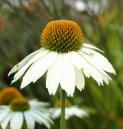The dried root of Arc'tium lappa Linné, and possibly of other species of Arctium, collected from plants of the first year's growth.
BOTANICAL CHARACTERISTICS. —Root biennial, fusiform; stem 1 to 3 feet high. Leaves strong-smelling, ovate, with cordate and crenate base, or lanceolate, with cuneate base. Involucre composed of imbricated coriaceous scales, the stiff, needle-like points of which are hooked. Heads solitary or clustered; flowers white or light purple, all tubular. Akenes oblong, flattened.
 DESCRIPTION OF DRUG.—A fusiform, fleshy root several inches in length and about 25 mm. (1 in.) thick, sometimes sliced longitudinally; grayish-brown, longitudinally wrinkled from drying, and having withered scales near the top; internally lighter colored, spongy, a cross-section showing a thick bark (in young roots, thin in old), the inner layer of which, and the meditullium, is traversed by broad medullary rays. Fracture horny. It has a slight unpleasant odor, and a sweetish, somewhat bitter taste.
DESCRIPTION OF DRUG.—A fusiform, fleshy root several inches in length and about 25 mm. (1 in.) thick, sometimes sliced longitudinally; grayish-brown, longitudinally wrinkled from drying, and having withered scales near the top; internally lighter colored, spongy, a cross-section showing a thick bark (in young roots, thin in old), the inner layer of which, and the meditullium, is traversed by broad medullary rays. Fracture horny. It has a slight unpleasant odor, and a sweetish, somewhat bitter taste.
Powder.—Brownish-gray. Characteristic elements: Parenchyma of cortex, thin-walled, elongated with glassy masses and sphaero-crystals of inulin; ducts large and small, with reticulate, simple pores; wood fibers and resin ducts, few.
CONSTITUENTS.—Mucilage, sugar, fat, a little tannin, a bitter glucoside, and inulin.
ACTION AND USES.—Diuretic, diaphoretic, and alterative. Dose: ½ to 2 dr. (2 to 8 Gm.). Fluidextractum Lappae, Dose: ½ to 2 fl. dr. (2 to 8 mils).
559. LAPPAE FRUCTUS.—BURDOCK FRUIT. A somewhat angular fruit, about 6 mm. (¼ in.) long, rough and wrinkled, and covered with short, stiff hairs, which are easily rubbed off. Very bitter. A tincture is used in psoriasis and other skin diseases.

